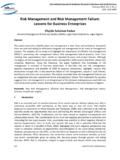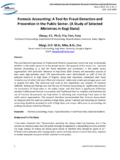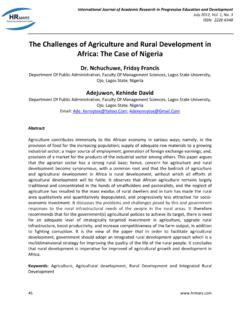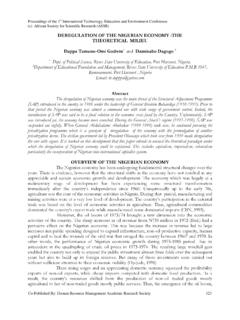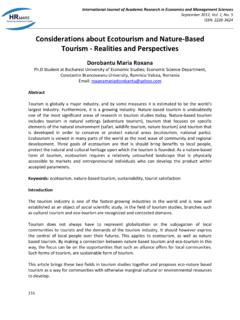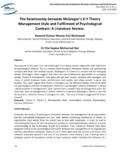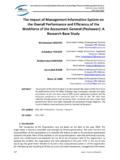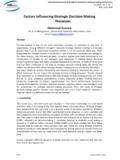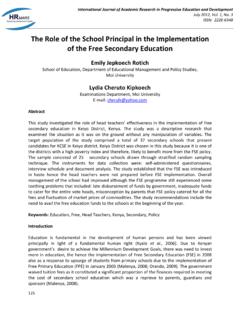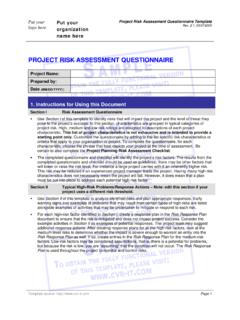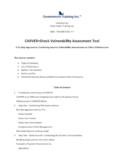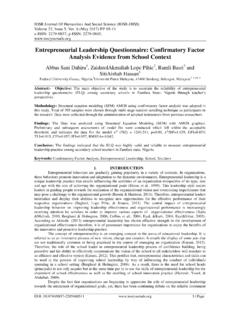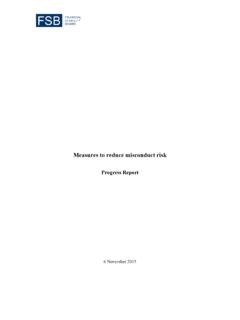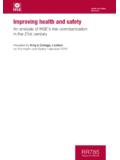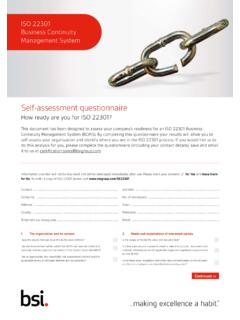Transcription of Modern Methods of Risk Identification in Risk …
1 International Journal of Academic Research in Economics and Management Sciences November 2012, Vol. 1, No. 6 ISSN: 2226-3624 67 Modern Methods of Risk Identification in Risk Management Ana-Maria DINU Junior PhD Valahia University of Targoviste, Romania, Christian University Dimitrie Cantemir , Bucharest Email: Abstract Enterprise risk management (ERM) takes a broad perspective on identifying the risks that could cause an organization to fail to meet its strategies and objectives. Many organizations do follow risk management but hardly ever do we get to see an organization following defined techniques to identify risks . There are many techniques to identify risks of which few common Methods are listed in this article which can be followed within any company.
2 These Methods of analysis help those that practice risk management to use established ways of identifying risk. It also helps them manage risk by either avoiding it, transferring it, reducing the impact of the risk, or by various other alternative solutions. Keywords: risk management, risks , Identification , Methods Introduction Risk is defined as an uncertain but potential element that always appears in the technical, human, social and political events, reflecting changes in the distribution of possible outcomes and subjective probability values and objectives, with possible damaging and irreversible effects1.
3 Risk management is an important part of planning for businesses. The process of risk management is designed to reduce or eliminate the risk of certain kinds of events happening or having an impact on the business. 1 Opran, C., Paraipan, L., & Stan, S. (2004). Risk management. Bucharest: Communicare. ro. International Journal of Academic Research in Economics and Management Sciences November 2012, Vol. 1, No. 6 ISSN: 2226-3624 68 Source: Figure 1. Risk management process The most important phases of risk management process include: the risk Identification , risk analysis and risk response.
4 A) The risk Identification is achieved by completing checklists, organizing meetings for identifying risks and analysis of archived documents. b) The risk analysis uses Methods such as: determining the expected value, Monte Carlo simulation and decision trees. c) The risk response includes measures and actions to reduce, eliminate or risk allocation. The purpose of risk management is to identify potential problems before they occur so that risk-handling activities may be planned and invoked as needed across the life of the product or project to mitigate adverse impacts on achieving objectives. Risk management is a continuous, forward-looking process that is an important part of business and technical management processes.
5 Risk management should address issues that could endanger the achievement of critical objectives. A continuous risk management approach is applied to effectively anticipate and mitigate the risks that have critical impact on the project. Effective risk management includes early and aggressive risk Identification through the collaboration and involvement of relevant stakeholders. Strong leadership across all relevant stakeholders is needed to establish an environment for the free and open disclosure and discussion of risk. Identifying risks is the first and perhaps the most important step in the risk management process.
6 If there is a failure to identify any particular risk, then the other steps in the risk management cannot be implemented for that risk. International Journal of Academic Research in Economics and Management Sciences November 2012, Vol. 1, No. 6 ISSN: 2226-3624 69 In order to manage risk, an organisation needs to know what risks it faces, and to evaluate them. Identifying risks is the first step in building the organisation's risk profile. There is no single right way to record an organisation's risk profile, but maintaining a record is critical to effective risk management.
7 The Identification of risk can be separated into two distinct phases: initial risk Identification (for an organisation which has not previously identified its risks in a structured way, or for a new organisation, or perhaps for a new project or activity within an organisation); on-going risk Identification (which is necessary to identify new risks which did not previously arise, changes in existing risks , or risks which did exist ceasing to be relevant to the organisation). In every case, risks should be prioritised in relation to the objectives. Care should be taken to avoid confusion between the impacts that may arise and the risks themselves, and to avoid stating risks that do not impact on objectives; equally care should be taken to avoid defining risks as simply the converse of the objectives.
8 A statement of a risk should encompass both the possible cause and the impact to the objective which might arise. Methods For Identifying risks Risk management uses formulas and templates to narrow in on and to identify risk. Which formulas and templates are used, is often determined by the industry that they are being practiced in. Some common Methods of risk Identification are: brainstorming, flowchart method, SWOT analysis, risk questionnaires and risk surveys. Brainstorming When objectives are stated clearly and understood by the participants, a brainstorming session drawing on the creativity of the participants can be used to generate a list of risks .
9 In a well facilitated brainstorming session, the participants are collaborators, comprising a team that works together to articulate the risks that may be known by some in the group. In the session, risks that are known unknowns may emerge, and perhaps even some risks that were previously unknown unknowns may become known. Facilitating a brainstorming session takes special leadership skills, and, in some organizations, members of the internal audit and ERM staff have been trained and certified to conduct risk brainstorming sessions. In addition to well-trained facilitators, the participants need to understand the ERM framework and how the brainstorming session fits into the ERM process.
10 The participants may very well be required to do some preparation prior to the session. In using this technique, one company familiar to the authors noted that, because the objectives were unclear to some of the participants, the process had to back up and clarify the objectives before proceeding. Using a cross-functional team of employees greatly increases the value of International Journal of Academic Research in Economics and Management Sciences November 2012, Vol. 1, No. 6 ISSN: 2226-3624 70 the process because it sheds light on how risks and objectives are correlated and how they can impact business units differently.
